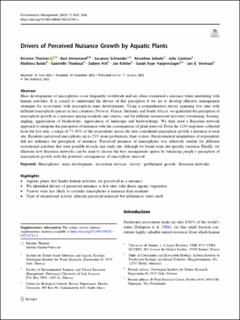| dc.contributor.author | Thiemer, Kirstine | |
| dc.contributor.author | Immerzeel, Bart | |
| dc.contributor.author | Schneider, Susanne Claudia | |
| dc.contributor.author | Sebola, Keneilwe | |
| dc.contributor.author | Coetzee, Julie | |
| dc.contributor.author | Baldo, Mathieu | |
| dc.contributor.author | Thiébaut, Gabrielle | |
| dc.contributor.author | Hilt, Sabine | |
| dc.contributor.author | Köhler, Jan | |
| dc.contributor.author | Harpenslager, Sarah Faye | |
| dc.contributor.author | Vermaat, Jan | |
| dc.date.accessioned | 2023-09-21T12:58:57Z | |
| dc.date.available | 2023-09-21T12:58:57Z | |
| dc.date.created | 2023-02-07T11:58:18Z | |
| dc.date.issued | 2023 | |
| dc.identifier.citation | Environmental Management. 2023, 71:1024-1036. | en_US |
| dc.identifier.issn | 0364-152X | |
| dc.identifier.uri | https://hdl.handle.net/11250/3091106 | |
| dc.description.abstract | Mass developments of macrophytes occur frequently worldwide and are often considered a nuisance when interfering with human activities. It is crucial to understand the drivers of this perception if we are to develop effective management strategies for ecosystems with macrophyte mass developments. Using a comprehensive survey spanning five sites with different macrophyte species in four countries (Norway, France, Germany and South Africa), we quantified the perception of macrophyte growth as a nuisance among residents and visitors, and for different recreational activities (swimming, boating, angling, appreciation of biodiversity, appreciation of landscape and birdwatching). We then used a Bayesian network approach to integrate the perception of nuisance with the consequences of plant removal. From the 1234 responses collected from the five sites, a range of 73–93% of the respondents across the sites considered macrophyte growth a nuisance at each site. Residents perceived macrophytes up to 23% more problematic than visitors. Environmental mindedness of respondents did not influence the perception of nuisance. Perceived nuisance of macrophytes was relatively similar for different recreational activities that were possible in each case study site, although we found some site-specific variation. Finally, we illustrate how Bayesian networks can be used to choose the best management option by balancing people’s perception of macrophyte growth with the potential consequences of macrophyte removal. | en_US |
| dc.language.iso | eng | en_US |
| dc.publisher | Springer | en_US |
| dc.rights | Navngivelse 4.0 Internasjonal | * |
| dc.rights.uri | http://creativecommons.org/licenses/by/4.0/deed.no | * |
| dc.title | Drivers of Perceived Nuisance Growth by Aquatic Plants | en_US |
| dc.type | Peer reviewed | en_US |
| dc.type | Journal article | en_US |
| dc.description.version | publishedVersion | en_US |
| dc.rights.holder | © 2023 The Authors | en_US |
| dc.source.pagenumber | 1024-1036 | en_US |
| dc.source.volume | 71 | en_US |
| dc.source.journal | Environmental Management | en_US |
| dc.identifier.doi | 10.1007/s00267-022-01781-x | |
| dc.identifier.cristin | 2123666 | |
| cristin.ispublished | true | |
| cristin.fulltext | original | |
| cristin.qualitycode | 1 | |

